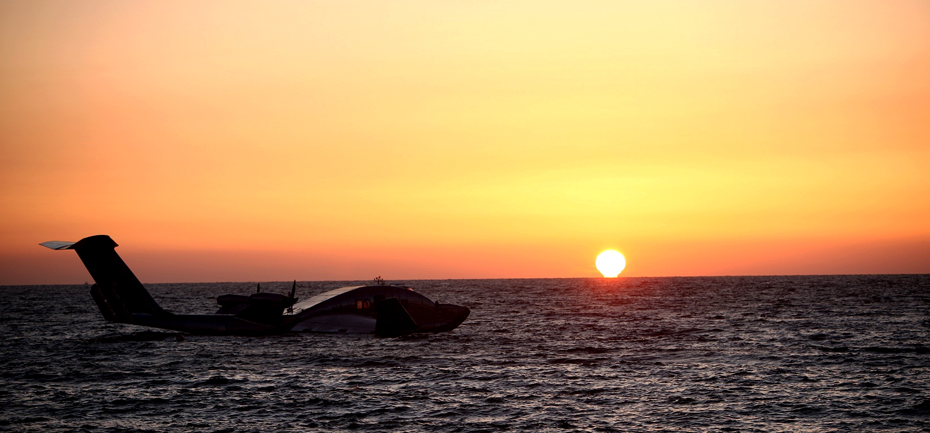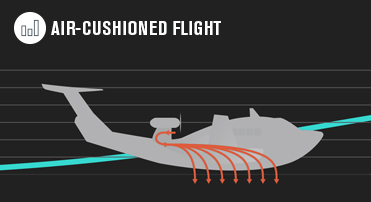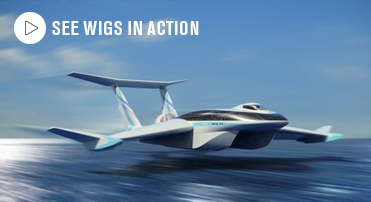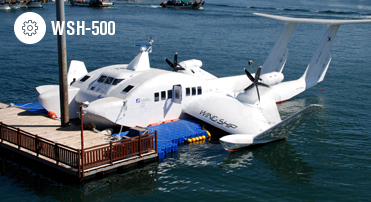



AIR-CUSHIONED FLIGHT
WIG craft like the WSH-500 are propelled on an air cushion of dynamic pressure created by their streamlined wings. The airflow stimulates thrust and also acts as an automatic stabilizer when the machine is flying close to the ground or over water. Hovercraft use the same principle, though whereas they blow air downward to create an air cushion, WIGs utilize natural air flow generated by forward movement and are thus much more efficient.
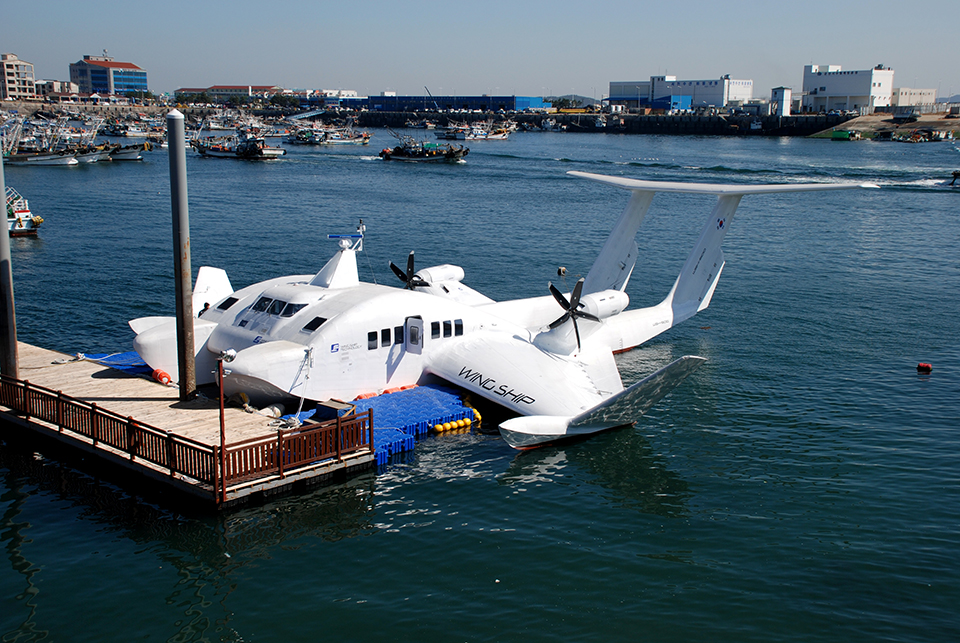
WSH-500 (50-SEATER)
WST completed manufacturing the first WSH-500 carrying about 50 passengers or 4.3 tons of freight at once.
Speed (top/operational): 105/95 knots
Size: LxBxD = 29.1 x 27.2 x 7.5 m
Maximum Take-off Weight: 18 metric tonnes
Wave height limits: 1.5 m normal take-off/ landing, 2.5 m extreme landing case
Fuel consumption: 450 kg/hr Range (nautical miles): 160NM (Max. 530NM)
Passenger capacity: Max 50 passengers
More information: http://wingship.com
Welcome to a vessel type that may well revolutionize sea transport and goes by the unlikely name of WIG. "Wing-in-ground-effect"(WIG) craft have had a long and painful birth and are still relatively unknown.
Developed for military use by the Soviet Union in the mid-1900s, the first WIGs disappointed, as they couldn't fly high enough. Now, eleven countries, including the USA, Japan, Russia, and Australia, are exploring their civil and military use. A South Korean-developed 50-seater WIG is ready for commercialization.
The renewed interest is hardly surprising when you consider WIG craft attributes: faster than any boat; cheaper to construct and operate than aircraft; fly over water, sand dunes, swamps and ice; need little or no infrastructure and can embark from/ dock at any port; transport passengers and freight of up to 50 tons in weight; no pilot's license necessary; high maneuverability; low fuel consumption and emissions.
Green transport
This remarkable craft resembles a seaplane but is categorized as a ship and crewed by mariners. It skims over water at a height of around four meters and up to 200 km/h, some three to five times as fast as a ship. With superior aerodynamics giving fuel consumption approximately half that of comparable aircraft, WIGs are being proclaimed the "next generation of green sea transport". They certainly appear to be a safe, fast, ecological and convenient transportation option that can set completely new standards, closing the gap between cheaper but slower ships, and faster but more costly aircraft.
Resting on an air cushion created by streamlined wings, a WIG functions on the same principle as the hovercraft, but its speed, range and maneuverability give it much greater commercial potential. WIGs are safe and simple to operate too, needing little effort to control thrust, flaps, elevators and rudders, and landing gently of their own accord if engines fail. They also return to the original altitude or pitch without any pilot control when disturbed by high winds. The IMO accepts experienced marine officers as pilots.
What is "ground effect"?
WIG craft exploit an aerodynamic phenomenon known as the "wing-in-ground effect" that reduces drag and fuel burn. Flying close to water (or land, if there are no obstacles), the wing downwash angle and tip vortices created by normal aircraft in flight are suppressed, resulting in a major drag reduction and outstanding cruise efficiency.
The ground effect was first recognized by Leonardo da Vinci, who observed how easy birds glide close to the ground. Flight pioneers the Wright brothers benefited from the effect without even knowing it existed - their first, low-power craft most probably never rose above its influence. In the Second World War pilots knew that they could limp home with engine damage or low fuel by flying just a few meters above the sea.
From Messerschmitts to Pelicans
The design of a craft for exploiting ground effect began in the early 1960s with Dr. Alexander Lippisch. An aerodynamics genius, he was the brains behind the World War II rocket aircraft Messerschmitt Me 163 and developed the delta wing, vital for both WIG craft and supersonic flight.
Lippisch's first two-seater WIG, built in the USA in 1963, was equipped with reversed delta wings. They produced dynamic pressure, creating thrust and an air cushion for reducing resistance and stabilizing the craft when flying close to the ground or water.
In 1966, Lippisch partnered with Hanno Fischer, whose company excelled in glass-fiber-reinforced plastic for aircraft construction and had facilities for further development of WIG craft.
Russia was also investigating ground effect in the 1960s and built the 540-tonne "Caspian Sea Monster" (known as ekranoplan in Russian), the largest WIG craft ever. Measuring 106 meters in length, with a wingspan of 40 m and massive 22 m tail to aid stability, it was capable of speeds of up to 500 km/h. Built by the Soviet Central Design Bureau of Hydrofoil Vehicles and powered by 10 turbofan jet engines, it was destroyed in a crash in 1980.
At the turn of the 21st century, Boeing considered building the largest plane ever, a WIG colossus called the Pelican Ultra Large Transport Aircraft (ULTRA). Measuring 152 meters from nose to tail, with a wingspan of 109 meters, it could fly 1,400 tonnes of cargo 10,000 nautical miles over water and 6,500 nautical miles over land in one journey. However, it remains on the drawing board.
From Germany to South Korea
After 50 years spearheading German WIG craft technology and know-how, Lippisch signed his Hoverwing technologies, including several related patents and technical data, over to the Korean Wing Ship Technology Corporation (WST), becoming their consultant in 2009.
B.J. Kang, head of WIG technologies at WST, explained how they have since designed new fuselage, propulsion and control systems and manufactured an extremely light craft. WST tested the WSH-500, which can carry about 50 passengers or 4.3 tonnes of freight, in 2013. He calls the craft "a technology of integration and a big first step towards a huge market for a novel form of transportation." The WSH-500 received its main construction certification by Lloyds Register in late 2013, and the certificate for machinery and equipment is scheduled for late 2014. WST already has an order for a military WSH-500 for the Korean navy, and Kang expects to see the first 50-seater WIGs in commercial service in late 2015 or early 2016.
From R&D to innovation
The Korean interest in WIG vessels began in 1990 when the Korea Research Institute of Ships and Ocean Engineering (KRISO) did R&D on several kinds of high-speed craft (hydrofoils, aircushion vehicles, WIG craft and hybrids). In 2007, the Korean government supported the establishment of Wing Ship Technology Corporation (WST) to develop and commercialize WIG craft developed by researchers at KRISO.
Keen to see the WIG revolution take off, the Korean government created regulations for WIG craft construction and amended the rules for marine traffic (COLRegs), and ship management (ISM) so WIG craft could be smoothly integrated into the maritime environment. Kang explains how the WSH-500 can reach all of Korea and its surrounding islands within one hour and China and Japan in one to three hours. He says the government is "actively fostering WIG craft as the future mode of transportation to China and Japan and because they are highly safe and eco-friendly."
High-speed ferries and OSVs
WST is now looking for investors to roll out the WSH-500 as the new solution for the high-speed coastal ferry and offshore supply vessel segments. It is three times faster than traditional crew boats and speed ferries, and its does away with seasickness problems and the noise and vibration of helicopter travel.
A WIG's high maneuverability and speed also make it ideal as a sea rescue craft or for bridging the infrastructure gaps in developing countries where waterways are often natural traffic arteries.
According to Kang, the main barrier for rapid uptake of WIG craft is skepticism: "The hydrofoil has been the fastest seagoing vessel for nearly 40 years, but the market needed to develop something faster and more efficient. Some think faster means more dangerous, but at sea, slow speed is more dangerous, as it creates crew boredom and impairs ship control," adding "Nothing about WIG craft is difficult, just different!"

